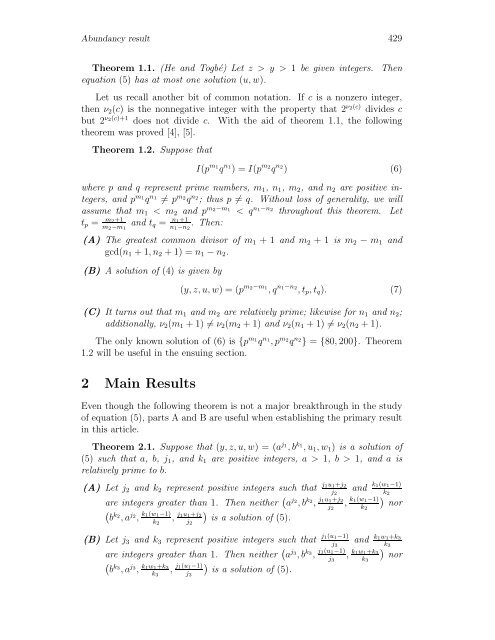An Abundancy Result for the Two Prime Power Case ... - HIKARI Ltd
An Abundancy Result for the Two Prime Power Case ... - HIKARI Ltd
An Abundancy Result for the Two Prime Power Case ... - HIKARI Ltd
Create successful ePaper yourself
Turn your PDF publications into a flip-book with our unique Google optimized e-Paper software.
<strong>Abundancy</strong> result 429<br />
Theorem 1.1. (He and Togbé) Let z > y > 1 be given integers.<br />
equation (5) has at most one solution (u, w).<br />
Then<br />
Let us recall ano<strong>the</strong>r bit of common notation. If c is a nonzero integer,<br />
<strong>the</strong>n ν 2 (c) is <strong>the</strong> nonnegative integer with <strong>the</strong> property that 2 ν2(c) divides c<br />
but 2 ν2(c)+1 does not divide c. With <strong>the</strong> aid of <strong>the</strong>orem 1.1, <strong>the</strong> following<br />
<strong>the</strong>orem was proved [4], [5].<br />
Theorem 1.2. Suppose that<br />
I(p m 1<br />
q n 1<br />
)=I(p m 2<br />
q n 2<br />
) (6)<br />
where p and q represent prime numbers, m 1 , n 1 , m 2 , and n 2 are positive integers,<br />
and p m 1<br />
q n1 ≠ p m 2<br />
q n 2<br />
; thus p ≠ q. Without loss of generality, we will<br />
assume that m 1 < m 2 and p m 2−m 1<br />
< q n 1−n 2<br />
throughout this <strong>the</strong>orem. Let<br />
t p = m 2+1<br />
m 2 −m 1<br />
and t q = n 1+1<br />
n 1 −n 2<br />
. Then:<br />
(A) The greatest common divisor of m 1 +1 and m 2 +1 is m 2 − m 1 and<br />
gcd(n 1 +1,n 2 +1)=n 1 − n 2 .<br />
(B) A solution of (4) is given by<br />
(y, z, u, w) =(p m 2−m 1<br />
,q n 1−n 2<br />
,t p ,t q ). (7)<br />
(C) It turns out that m 1 and m 2 are relatively prime; likewise <strong>for</strong> n 1 and n 2 ;<br />
additionally, ν 2 (m 1 +1)≠ ν 2 (m 2 +1)and ν 2 (n 1 +1)≠ ν 2 (n 2 +1).<br />
The only known solution of (6) is {p m 1<br />
q n 1<br />
,p m 2<br />
q n 2<br />
} = {80, 200}. Theorem<br />
1.2 will be useful in <strong>the</strong> ensuing section.<br />
2 Main <strong>Result</strong>s<br />
Even though <strong>the</strong> following <strong>the</strong>orem is not a major breakthrough in <strong>the</strong> study<br />
of equation (5), parts A and B are useful when establishing <strong>the</strong> primary result<br />
in this article.<br />
Theorem 2.1. Suppose that (y, z, u, w) =(a j 1<br />
,b k 1<br />
,u 1 ,w 1 ) is a solution of<br />
(5) such that a, b, j 1 , and k 1 are positive integers, a>1, b>1, and a is<br />
relatively prime to b.<br />
(A) Let j 2 and k 2 represent positive integers such that j 1u 1 +j 2<br />
are integers greater than 1. Then nei<strong>the</strong>r ( a j 2<br />
,b k 2<br />
, j 1u 1 +j 2<br />
(<br />
b<br />
k 2<br />
,a j 2<br />
, k 1(w 1 −1)<br />
k 2<br />
, j 1u 1 +j 2<br />
)<br />
j 2<br />
is a solution of (5).<br />
j 2<br />
and k 1(w 1 −1)<br />
k 2<br />
j 2<br />
, k 1(w 1<br />
)<br />
−1)<br />
k 2<br />
nor<br />
(B) Let j 3 and k 3 represent positive integers such that j 1(u 1 −1)<br />
j 3<br />
and k 1w 1 +k 3<br />
k 3<br />
are integers greater than 1. Then nei<strong>the</strong>r ( a j 3<br />
,b k 3<br />
, j 1(u 1<br />
)<br />
−1)<br />
j 3<br />
, k 1w 1 +k 3<br />
k 3<br />
nor<br />
(<br />
b<br />
k 3<br />
,a j 3<br />
, k 1w 1 +k 3<br />
k 3<br />
, j 1(u 1<br />
)<br />
−1)<br />
j 3<br />
is a solution of (5).
















